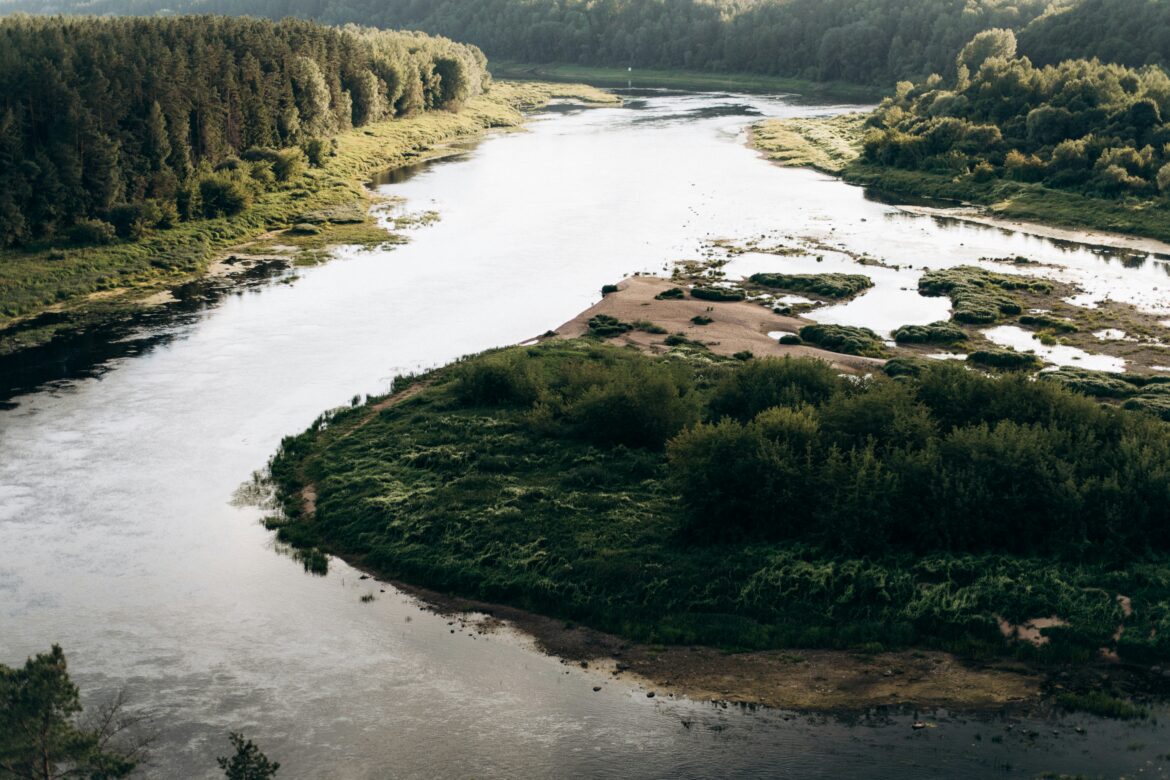1. Visit the Kraslava Palace and Park
One of the most prominent landmarks in Kraslava is the Kraslava Palace. Built in the 18th century, this historical gem is surrounded by a beautiful park. The park is perfect for leisurely walks and offers scenic views of the Daugava River. The palace is an excellent example of classicist architecture, and you can explore its stunning interiors. Don’t forget to visit the nearby garden and take in the lush greenery.
2. Velnezers Lake: A Serene and Mysterious Destination
Velnezers Lake, also known as Čertoks, captivates visitors with its crystal-clear water and fascinating legends. The lake reaches a depth of 17 meters, and in some areas, visibility extends up to 12 meters. Since no streams or springs flow in or out, the water remains undisturbed and strikingly clear.
Locals have shared eerie stories for generations. Many claim that people often get lost near the lake, struggling to find their way back. Because of its unique ecosystem, a 53-hectare protected area was established in 1977. Dense pine forests surround the lake, while small bogs and coastal vegetation add to the area’s charm. Whether you seek tranquility or adventure, Velnezers Lake offers an unforgettable experience.
3. Discover the Kraslava History Museum
For those interested in history, the Kraslava History Museum is a must-visit. Located in a former school building, the museum showcases the town’s history and its cultural heritage. The exhibits include artifacts from different periods, such as the medieval and Soviet eras. You’ll gain a deeper understanding of the town’s past and the people who shaped it.
4. Nature Park “Daugavas Loks”: A Hidden Gem of Kraslava
Daugavas Loki, a breathtaking nature park, stretches along the Daugava River between Krāslava and Naujene. Covering 129.9 km², it protects the region’s unique landscape, rich biodiversity, and cultural heritage. Established in 1990, the park preserves the river valley’s natural beauty and historical significance.
Its most striking feature is the series of nine massive river bends, each stretching 4 to 6 km, with only 2 to 3 km of straight river in between. Every bend has a name, adding character to this scenic wonder. Recognized for its significance, the park earned a place on Latvia’s national UNESCO World Heritage list in 2011.
Visitors can explore stunning viewpoints, enjoy peaceful hikes, and admire diverse wildlife. Whether you love nature, history, or photography, Daugavas Loki offers an unforgettable escape.
5. Pilori Oak Grove: A Rare Natural Gem by Lake Ežezers
Pilori Oak Grove, one of Latvia’s rare pure oak forests, sits on the shores of Lake Ežezers—the lake with the most islands in the Baltics. This serene spot offers a unique glimpse into the country’s rich natural heritage.
6. Lake Dridzis: The Deepest and Most Scenic Lake in the Baltics
A small parking area, a scenic walking path, and an information stand make exploring easy. Visitors can also enjoy a boardwalk, a rest area, and a WC. Protected since 1928, this peaceful grove is perfect for nature lovers seeking tranquility and breathtaking lake views.
Lake Dridzis holds the title of the deepest lake in the Baltic States, reaching a maximum depth of 65.1 meters. With its elongated, winding shape, the lake resembles a river, forming numerous bays, peninsulas, and nine islands. The largest, Bernatu Sala, spans 13.9 hectares.
Stretching 11 km along its shore and reaching up to 1 km in width, the lake offers breathtaking panoramic views from the surrounding hills. Located within a protected nature park, Lake Dridzis is a must-visit for those who appreciate unspoiled landscapes and tranquil waters.
7. Explore the Daugava River
The Daugava River is the lifeblood of Kraslava. It offers various outdoor activities like boat tours and fishing. You can rent a kayak or enjoy a relaxing boat ride along the river to experience the stunning landscapes of the region. The views of the surrounding countryside, especially during sunset, are breathtaking. The Daugava River is an excellent place to unwind and connect with nature.
8. Krāslava Central Town Square: A Historic Hub of Trade and Culture
Dating back to the 18th century, Krāslava’s Central Town Square has long been the heart of the town. Originally designed in a rectangular shape, it was lined with wooden and stone buildings, including merchant houses, workshops, stables, and trade shops.
The Town Hall, once the square’s main structure, housed a customs office, weighing rooms, and later, commercial spaces. A key feature was the chemist’s shop, established in the 1730s and known as “The Lion’s Chemist” by 1924. Though closed briefly in 1939, it reopened in 1940 and continues to serve the town.
Today, the square remains a cultural and historical landmark, offering a glimpse into Krāslava’s past and a vibrant place to explore.
9. Karnicky Monument and Telescope: A Tragic Love Story with Stunning Views
Karnicky Hill is linked to a tragic 1838 love story between Emilia Plater and Polish officer Joseph Karnicky. Forbidden to marry, they planned a double suicide. Joseph shot himself, but Emilia’s servant saved her at the last moment. A monument marks the spot with the inscription: “Don’t judge, and you won’t be judged.”
Legend says a spring appeared the next day, bringing eternal love to those who drink from it on Midsummer’s Night. In 2020, a viewing telescope was installed, offering breathtaking views of the Daugava bends and Krāslava’s architecture.
10. Adamovas Castle Mound & Krāslava Chair: Scenic Views and Local Legends
Adamovas Castle Mound – A Historic Lookout
As visitors approach Krāslava from Riga, they are welcomed by Adamovas Castle Mound, which sits on the edge of the ancient Daugava Valley between two deep ravines. Rising 40 meters high, this hill was once inhabited, much like many other sites along the Daugava River. The construction of the Riga-Krāslava highway in 1958 destroyed unexplored archaeological remains, but the area has since become a popular observation point. Today, locals and visitors alike flock to the site to enjoy breathtaking views and take peaceful walks.
Krāslava Chair – A Symbol of the Town
At one of the best viewpoints overlooking Krāslava and the winding Daugava River stands a 2.5-meter-tall wooden chair. This unique landmark draws inspiration from the town’s name. “Krāslava” is believed to come from the Latgalian word krāsls, meaning “chair,” as the Daugava’s bends resemble the shape of a seat. Historical accounts support this theory, as rafts once ran aground here, forming a “krāsls.” Created by the local craftsman society Kruoslovys amatnīku broliste, the Krāslava Chair offers a perfect spot to capture the town’s essence and its connection to the river.
Kraslava, Latvia, may be small, but it offers a wealth of experiences for visitors. From exploring historical sites to enjoying outdoor activities along the Daugava River, there’s no shortage of things to do. Whether you’re looking for relaxation or adventure, Kraslava is the perfect destination for your next getaway. Don’t miss the chance to experience this hidden gem of Latvia.

